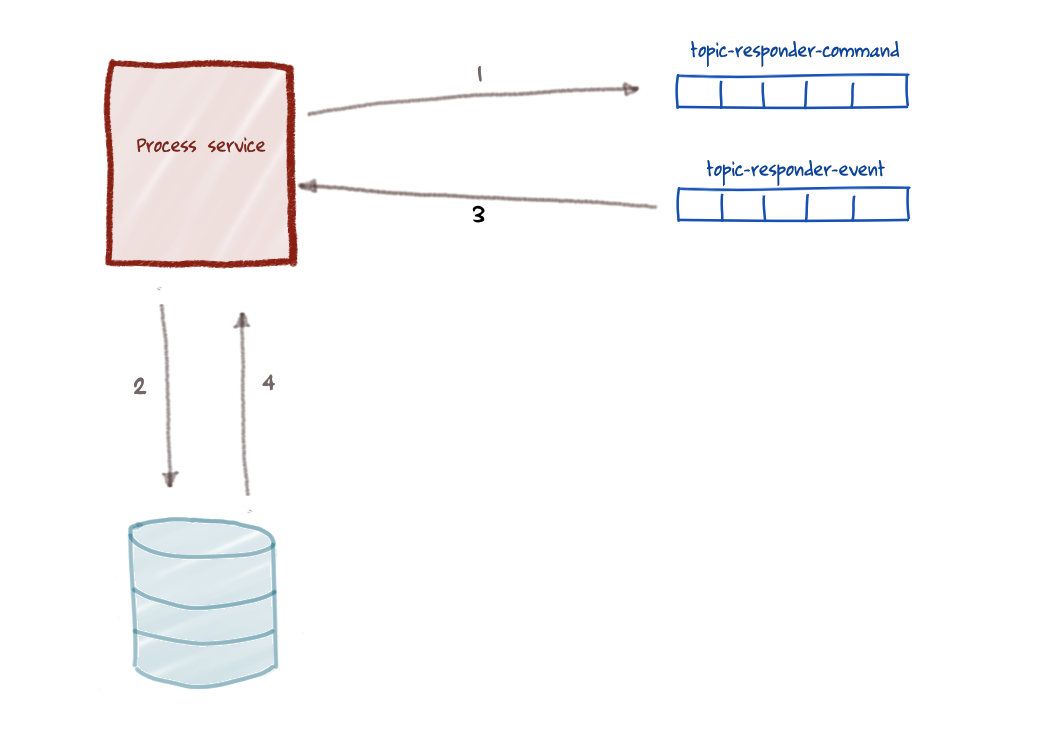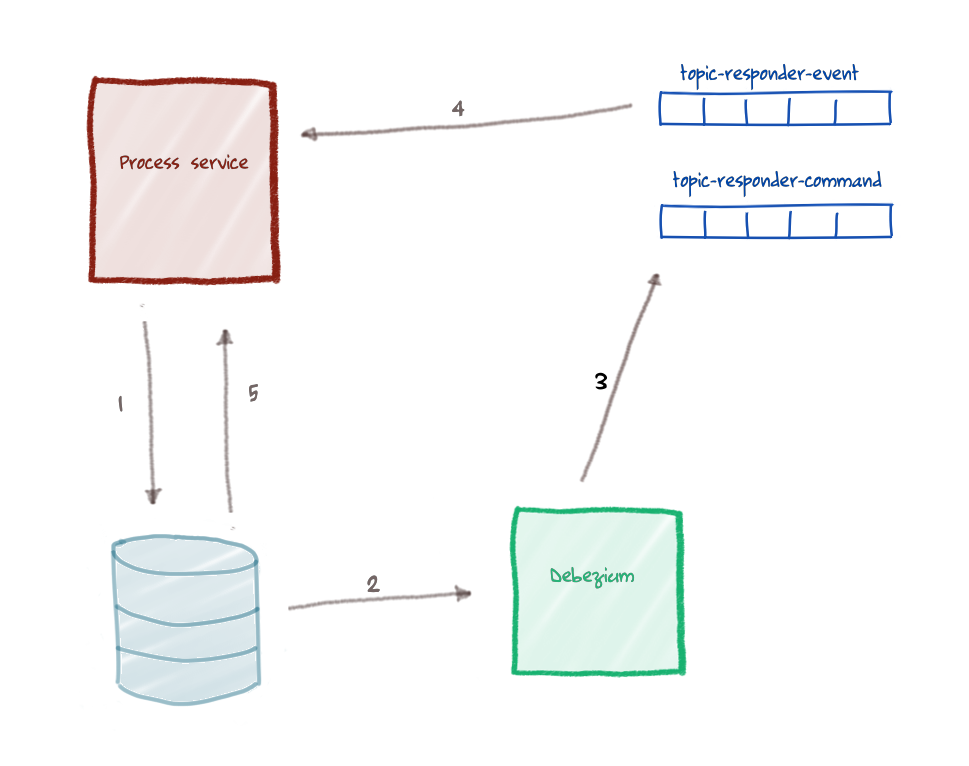1. Overview
This post is about the following powerhouse components of the Red Hat Application Services portfolio working in close collaboration with one another to solve both business and technical problems:
- Red Hat Process Automation Manager
- Red Hat AMQ Streams
- Change Data Capture component (Debezium) of Red Hat Integration Change Data Capture (CDC) is an architecture pattern that traditionally has been implemented to expose events in motion from what otherwise are typically fairly static data silos. (ie: relational databases). The Debezium component of the Red Hat Integration product is a CDC implementation.
In particular, this post documents a rather novel use of Debezium to solve the problem of dual-writes in a business process.
| Related Tech Talk: [Friends don’t let friends do dual writes!]( | https://developers.redhat.com/devnation/tech-talks/dual-writes-kafka-debezium?sc_cid=7013a000002wMgZAAU) |
2. Happy Path Business Processes
The Emergency Response demo is an event-driven architected application using Red Hat AMQ Streams (aka: Apache Kafka) on OpenShift Container Platform. Red Hat Process Automation Manager (RH-PAM) is also used to orchestrate the message-driven interactions between all of the services of the application. The BPMN2 business process model (named: incident-process.bpmn) that represents this orchestration at runtime is as follows:

This business process, when viewed in its end-to-end entirety, can be classified as asynchronous. This is because the business process defines wait-states that decouple execution of its various tasks from one another. This asynchronous business process paradigm is best discussed in the seminal article: Your Starbucks Coffee Shop Does Not Use Two-Phase Commit.
However, between these wait-states, the business process executes synchronously using a transaction. This synchronous sequence of steps is depicted in detail as follows:

- A transaction is started, the process service retrieves the state of a process instance from the database and executes a series of tasks. In the ER-Demo incident-process, one of these tasks is a workitem that sends a Kafka message to the
topic-responder-commandtopic of AMQ Streams. (related: the ER-Demo responder-service consumes and processes this message from that topic). - Within this same transaction, the process instance reaches a signal node (which is a wait-state) and this transaction is committed (along with the state of the process instance at that time) to the RH-PAM database: PostgreSQL. So within this single syncronous transaction there are two writes: a write to a Kafka topic and a write to the RH-PAM PostgreSQL database.
- The ER-Demo responder-service responds back to the process service via the
topic-responder-eventtopic. - The process service consumes the message on the
topic-responder-eventtopic and in a new transaction pulls the process instance state from the database and executes downstream work until the next wait-state in the business process is reached.
So to recap, the ER-Demo business process is asynchronous when viewed in its entirety but is synchronous when executing between wait-states. Under idealistic circumstances this approach generally works fine.
3. Pitfalls of Dual-Writes
In the ER-Demo application, even though the use of synchronous transactions is isolated to execution between wait-states and these transactions tend to be short lived (ie: ~ 10 millis), problems still occur.
In particular, what has been observed is that in some cases during these synchronous transactions, the delivery, processing and reply of Kafka messages(steps 1 & 3) completes before the process instance flush to the PostgreSQL database (Step 2). When this occurs, the process instance is not yet waiting for the next signal (to initiate the next synchronous transaction), and subsequently the signal is lost. The process instance does not resume execution and hangs at the signal node.
This problem most often occurs during execution of the Update Responder Availability task of the ER-Demo’s incident-process:

4. Outbox Pattern to the Rescue
To some degree, this problem could be resolved if AMQ Streams / Apache Kafka supported XA transactions (aka: Two-Phase Commit (2PC) ). Even then, however, 2PC introduces its own slew of unintended consequences and considerations.
To resolve the problem of dual-writes in a single transaction experienced in the ER-Demo application, the outbox pattern has been implemented using technology from the Red Hat sponsored Debezium open-source project . The approach taken is best discussed in this blog post.
Using the outbox pattern, the problem of dual-writes is resolved in the ER-Demo application via the following series of steps:

- Process execution hits the signal node: process instance state and an outbox event are persisted to the same database as part of a transaction commit. Unlike the original architecture, there is now only this single write in this transaction. The outbox event contains the message payload to be sent to the
topic-responder-command. This outbox event is persisted in an outbox table (which is co-located in the same database as the RH-PAM process engine tables). -
Debezium scans the transaction log of the database and picks up the insert in the outbox table. The record to the outbox table is deleted immediately after creation and Debezium ignores the delete logs from Postgres. This immediate deletion of the record is to ensure that the outbox table does not grow endlessly.
- Debezium sends the outbox event to the
topic-responder-command - The process service consumes the reply message originating from the responder-service and signals the embedded process engine.
- The process engine loads the process instance from the database in a new transaction.
With the outbox pattern, the message to the topic-responder-command is only sent after the transaction is committed to the database. It is no longer the process service that sends the message. Rather the message payload is persisted together with the process state, and Debezium picks up the change event in the database and sends the message to the topic-responder-command topic.
5. GIVE ME THE DETAILS !!!!
Details about the implementation of the outbox pattern in the ER-Demo application are as follows:
- Debezium requires use of a PostgreSQL 10 database that includes a decoding output plugin. This decoding output plugin extracts changes committed to the PostgreSQL transaction log. In the ER-Demo application, the RH-PAM process engine embedded in the process-service leverages a PostgreSQL 10 database that includes this decoding output plugin:
$ ERDEMO_NS=user1-er-demo # CHANGE ME (if needed) $ oc get dc process-service-postgresql \ -n $ERDEMO_NS \ -o=jsonpath='{.spec.template.spec.containers[].image}' quay.io/emergencyresponsedemo/postgres-10-decoderbufs-fedora -
Debezium builds upon the Kafka Connect project. As such, implementation of the outbox pattern in the ER-Demo requires a Kafka Connect deployment (provided by Red Hat AMQ Streams). This deployment can be viewed as follows:
$ oc get kafkaconnect.kafka.strimzi.io -n $ERDEMO_NS NAME DESIRED REPLICAS kafka-connect 1 $ oc get deployment kafka-connect-connect -n $ERDEMO_NS NAME READY UP-TO-DATE AVAILABLE AGE kafka-connect-connect 1/1 1 1 2d2h $ oc get deployment kafka-connect-connect -n $ERDEMO_NS \ -o=jsonpath='{.spec.template.spec.containers[].image}' quay.io/emergencyresponsedemo/strimzi-debezium-postgresql:1.4.0-1.1.2.FinalThe image used in the Kafka Connect contains the Java code which reads the changes produced by the PostgreSQL decoding output plug-in.
-
Debezium pulls configuration information about the database it is to scan from a kafkaconnector (provided by Red Hat AMQ Streams) (NOTE: the following command makes use of the jq library):
$ oc get kafkaconnector.kafka.strimzi.io \ debezium-postgres-process-service \ -o json -n $ERDEMO_NS | jq .spec { "class": "io.debezium.connector.postgresql.PostgresConnector", "config": { "database.dbname": "rhpam", "database.hostname": "process-service-postgresql.user10-er-demo.svc", "database.password": "PiqOKMyDWWYv", "database.port": "5432", "database.server.name": "rhpam1", "database.user": "postgres", "schema.whitelist": "public", "table.whitelist": "public.process_service_outbox", "tombstones.on.delete": "false", "transforms": "router", "transforms.router.route.topic.replacement": "topic-${routedByValue}", "transforms.router.table.fields.additional.placement": "type:header:eventType", "transforms.router.type": "io.debezium.transforms.outbox.EventRouter" }, "tasksMax": 1 } -
The same Debezium configuration information can be pulled directly from Debezium’s RESTful API:
$ oc rsh `oc get pod -n $ERDEMO_NS \ | grep "^process-service-postgresql" \ | grep "Running" | awk '{print $1}'` $ curl kafka-connect-connect-api:8083/connectors/debezium-postgres-process-service -
The outbox table that stores the json message to be delivered by Debezium to the topic-responder-command topic resides in the rhpam database and can be viewed as follows:
$ oc rsh `oc get pod -n $ERDEMO_NS \ | grep "^process-service-postgresql" \ | grep "Running" | awk '{print $1}'` $ psql rhpam rhpam=# \d process_service_outbox Column | Type | Collation | Nullable | ---------------+------------------------+-----------+----------+ id | uuid | | not null | aggregatetype | character varying(255) | | not null | aggregateid | character varying(255) | | not null | type | character varying(255) | | not null | payload | text | | | Indexes: "process_service_outbox_pkey" PRIMARY KEY, btree (id) rhpam=# select * from process_service_outbox; 0Notice that (as expected) there are zero records in the table due to the immediate deletion of records to this table.
-
The code that writes to the process_service_outbox table when sending a message to the ER-Demo responder service is implemented in a custom RH-PAM workItemHandler :
if (updateResponderCommandDestination.equals(destination)) { OutboxEvent outboxEvent = null; try { outboxEvent = new OutboxEvent("responder-command", key, msg.getMessageType(), new ObjectMapper().writeValueAsString(msg)); } catch (JsonProcessingException e) { throw new RuntimeException(e); } outboxEventEmmitter.emitEvent(outboxEvent); } -
The code that inserts and then immediately deletes the record in the process_service_outbox table is here :
@Component public class OutboxEventEmitter { @PersistenceContext private EntityManager entityManager; public void emitEvent(OutboxEvent event) { entityManager.persist(event); entityManager.remove(event); // Remove immediately upon creation } }
6. Conclusion
The Red Hat sponsored Debezium community project provides powerful capabilities to be employed in modern cloud-native architected business applications.
By leveraging Debezium to implement the outbox pattern, the ER-Demo greatly benefits by executing a single write in Update Responder Availability transaction.
It now completely avoids all unintended consequences of dual writes in that synchronous transaction.
The outbox pattern is just one of many use-cases to employ Debezium.
We encourage you to familiarize yourself with its capabilities and usecases to employ it in your cloud-native architectured business applications.